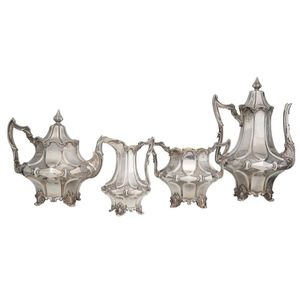Victorian Gothic Revival Tea and Coffee Service
A Victorian sterling silver four piece tea and coffee service, by Joseph Angell Jr, London, circa 1849, in the Gothic revival manner, comprising a coffee pot, teapot, creamer and sugar bowl, the creamer and sugar bowl with gilt washed interiors, all with embossed and chased decoration and standing on scroll feet, 2372gms sterling silver, coffee pot 31 cm high, teapot 22.5 cm high
You must be a subscriber, and be logged in to view price and dealer details.
Subscribe Now to view actual auction price for this item
When you subscribe, you have the option of setting the currency in which to display prices to $Au, $US, $NZ or Stg.
This item has been sold, and the description, image and price are for reference purposes only.
- Circa - A Latin term meaning 'about', often used in the antique trade to give an approximate date for the piece, usually considered to be five years on either side of the circa year. Thus, circa 1900 means the piece was made about 1900, probably between 1895 and 1905. The expression is sometimes abbreviated to c.1900.
- Sterling Silver - Sterling silver is a mixture of 92.5% pure silver and 7.5% of another metal, usually copper. Fine silver is 99.9% pure silver, and is relatively soft and the addition of the very small amount of copper gives the metal enough strength and hardness to be worked into jewellery, decorative and household objects.
- Embossed / Repousse - Embossing, also known as repousse, is the technique of decorating metal with raised designs, by pressing or beating out the design from the reverse side of the object.It is the opposite of chasing, where the decoration is applied from the front. An embossed or repoussed object may have chasing applied to finish off the design.
- Victorian Period - The Victorian period of furniture and decorative arts design covers the reign of Queen Victoria from 1837 to 1901. There was not one dominant style of furniture in the Victorian period. Designers used and modified many historical styles such as Gothic, Tudor, Elizabethan, English Rococo, Neoclassical and others, although use of some styles, such as English Rococo and Gothic tended to dominate the furniture manufacture of the period.
The Victorian period was preceded by the Regency and William IV periods, and followed by the Edwardian period, named for Edward VII (1841 ? 1910) who was King of the United Kingdom and the British Dominions and Emperor of India for the brief period from 1901 until his death in 1910. - Angell Family of Silversmiths - There were a number of members of the Angell family who were silversmiths, commencing with Joseph Angell I (also expressed as Joseph Angell, Senior), and his brothers John Angell and Abraham Angell.
On the retirement of Joseph Angell I in 1948, from what had become the leading London silverware workshop, the business was taken over by his son, Joseph Angell II (also expressed as Joseph Angell, Junior), (1815 - 1891).
Joseph Angell II exhibited at the at the 1851 Great Exhibition, the 1853 New York Exhibition, and the 1862 International Exhibition winning medals at each event.
His career is marked by the rich silver items crafted and decorated with chiseling, reliefs and enamels, including trays, tea and coffee sets, jugs, centrepieces and vases
The Victoria and Albert Museum in London holds a number of silver objects by Jospeh Angell II. - Chasing - The method of decorating gold and silver objects using a punch and hammer so that the design appears in relief. Flat or surface chasing is done from the front giving the item definition, but not cutting into the metal.
Chasing is the opposite technique to repousse, but an object that has repousse work, may then have chasing applied to create a finished piece.
This item has been included into following indexes:
- Angell family (England) - silversmiths 67
- Angell, Joseph (London) - silver, maker or retailer 36
- coffee sets/services - silver items 412
-
tea sets/services
- silver, four piece 301
- silver, Victorian 306
